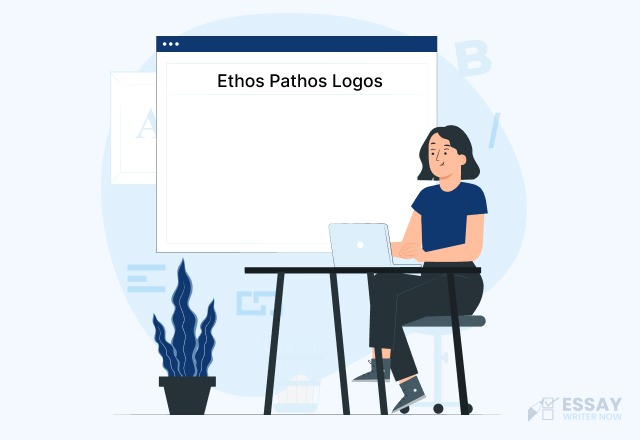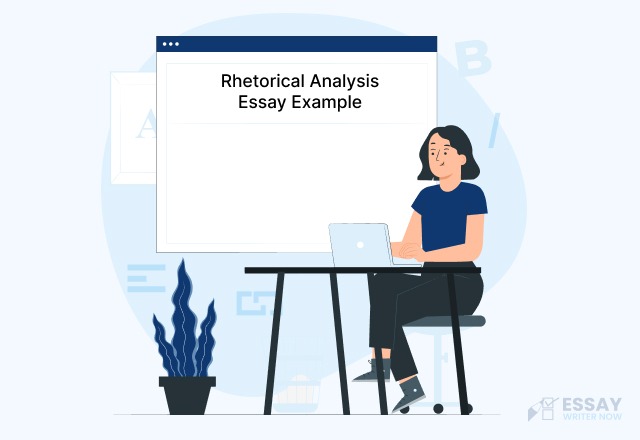Ethos, Pathos, and Logos Definition
People may not always agree with what you have to say. Convincing them to see things your way can be difficult, but it's important to try. This is because convincing people usually requires using different modes of persuasion, depending on the topic you're writing about.
There are three main ways to convince someone of your argument presented - ethos, logos, and pathos. Aristotle came up with these terms, and each one is used in different persuasive writings such as speeches, essays, and advertising and analytical writings as a rhetorical analysis essay.
There are three types of persuasive appeals. Keep reading to understand what each one is and why it matters.
- Ethos
An ethos, or an appeal to ethics, is a way for a writer to try and convince the audience of something. This type of appeal uses the credibility, authority, and character of the speaker or writer to make people believe in the specific concept or idea.
The writer uses a strong personality to get his idea across to people. This makes the audience understand and believe it. This can be very helpful when writing persuasive or argumentative content.
Many famous writers have used ethos to persuade their readers. Harper Lee's "To Kill a Mockingbird" and John Steinbeck's "East of Eden" are two examples.
- Pathos
Pathos is a rhetorical appeal that aims to evoke the emotions of people. Writers believe that the best way to persuade people from their writings and speeches is by making them emotional. People will listen and read anything that will make them feel something.
The content creator uses stories and experiences to form an argument and defend it. William Shakespeare often used pathos in his work, including Romeo and Juliet.
Other literature, like Pride and Prejudice and The Adventures of Tom Sawyer, also use persuasive techniques like pathos.
- Logos
Logos appeals to logic that uses facts and statistics to convince the audience. In this technique, the writer forms his standpoint and proves it using reasoning and facts.
Logos is a Greek word that means ‘reason’ or ‘plan.’ When using this approach to write your essays and papers, make sure you have strong evidence to support your points.
Many famous historical and literal analogies use logos, or reasoning, to convince the audience. Examples include 1984 by George Orwell and The Merchant of Venice by William Shakespeare.
Usage of Ethos, Pathos, and Logos
It can be difficult to use rhetorical appeals correctly, but with practice, it is possible. If you are assigned an argumentative paper, choose to use ethos (or credibility), pathos (or emotion), or logos (or logic) to get your point across.
Your strategy for writing an assignment depends on its topic. Not every topic allows you to use emotions to engage the audience. Some subjects only require that you discuss them logically and factually.
Different writers use different approaches to writing to make their points. In the following passage, look at how the writers use different rhetorical strategies to support their arguments.
Usage of Ethos
The following examples of using ethos will help you understand the concept better.
- "I have a lot of experience working in public service for many years. I am always willing to help the people of this community, and I can also work with people who have different opinions than me. This makes me the best candidate for mayor."
- "Our 50 years of experience and our qualified technicians are evidence that we are experts in roofing contracting. Our satisfied customers over the years have come to expect nothing but the best from us."
- "After conducting dozens of archaeological expeditions all over the world, I am confident that those potsherds are Mesopotamian in origin."
Usage of Pathos
Pathos is a rhetorical term that refers to emotions to persuade an audience. The following are some tips of how you can use pathos to appeal to your audience's emotions:
- Make your readers feel what you're feeling. Express your thoughts and feelings honestly, and let your readers see the situation through your eyes.
- Use stories or personal experiences to illustrate your points. People are more likely to respond emotionally to stories than abstract arguments or statistics.
- Appeal to people's values and beliefs. Everyone has certain important values, so find ways to connect those values to the topic at hand.
Not sure how to use pathos to appeal and emotionally persuade the audience through your content? Check out the examples below:
- “They have worked hard to defeat everything we have tried to do. They do not care who gets hurt in the process. Make no mistake, they are our enemies, and they will not stop until we are all defeated.”
- “This is your opportunity. You will never be satisfied in life if you don't take this chance. Do you want to spend the rest of your year regretting not taking this opportunity?”
- “You've put up with your boss's disrespectful behavior for too long. You've wasted countless hours and missed important family events. It's time to stand up for yourself and demand better treatment.”
Usage of Logos
A logo is a logical argument that defends the writer's point. It should make sense to the reader. Using logos can be hard, but the following examples can help you understand.
“There is plenty of evidence that points to the defendant being guilty of the robbery. The fingerprints, lack of an alibi, and clear motive support this assertion.
In addition, there is video footage of the suspect breaking into the building. This evidence leaves no doubt that the defendant is responsible for the crime.”
"Over 100 studies reviewed by other scientists have been conducted in the past ten years. None of them suggest that this is an effective treatment for hair loss."
"A study by experts from NASA and five other space agencies found that a moon colony is possible with international cooperation."
Ethos, Pathos, and Logos Examples
Check out our additional examples of ethos, pathos, and logos to help make your content more convincing and persuasive.
Ethos, Pathos, and Logos Writing Tips
Here are some tips to help you learn the techniques of using different modes and write essays more interestingly and persuasively:
- Make sure your tone of voice is interesting and engaging for readers. This means that your writing should be persuasive.
- Make use of logos for inductive or deductive reasoning. This can be difficult if there are no logical fallacies. Also, you need to be careful when using it so that you don't get too drawn in by the audience's feelings.
- Proofreading your work is important. It can help you figure out how well your content will work for people. So proofread it before you show it to anyone.
In conclusion, mastering the three pillars of persuasion—ethos, pathos, and logos—can significantly enhance the effectiveness of your arguments.By thoughtfully incorporating these elements, you can craft a persuasive argument that resonates with your audience and effectively conveys your point of view
If you are struggling with these logical appeals, then get in touch with an expert essay writing service that can help you out!



